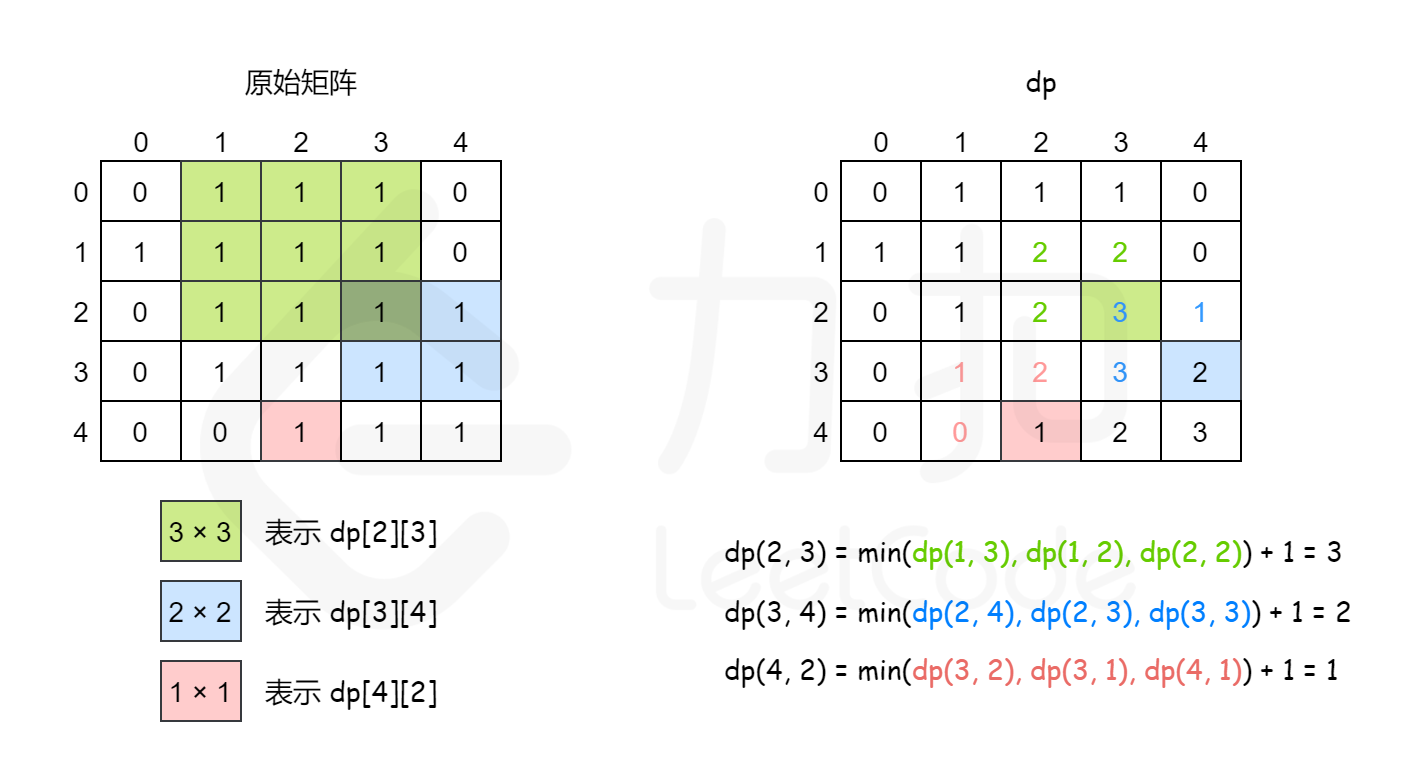Given an m x n binary matrix filled with 0's and 1's, find the largest square containing only 1's and return its area.
Example 1:
Input: matrix = [["1","0","1","0","0"],["1","0","1","1","1"],["1","1","1","1","1"],["1","0","0","1","0"]] Output: 4
Example 2:
Input: matrix = [["0","1"],["1","0"]] Output: 1
Example 3:
Input: matrix = [["0"]] Output: 0
Constraints:
m == matrix.lengthn == matrix[i].length1 <= m, n <= 300matrix[i][j]is'0'or'1'.
在一个由 '0' 和 '1' 组成的二维矩阵内,找到只包含 '1' 的最大正方形,并返回其面积。
示例 1:
输入:matrix = [["1","0","1","0","0"],["1","0","1","1","1"],["1","1","1","1","1"],["1","0","0","1","0"]] 输出:4
示例 2:
输入:matrix = [["0","1"],["1","0"]] 输出:1
示例 3:
输入:matrix = [["0"]] 输出:0
提示:
m == matrix.lengthn == matrix[i].length1 <= m, n <= 300matrix[i][j]为'0'或'1'
| Language | Runtime | Memory | Submission Time |
|---|---|---|---|
| typescript | 4864 ms | 47.4 MB | 2023/03/25 18:12 |
function maximalSquare(matrix: string[][]): number {
const m = matrix.length;
const n = matrix[0].length;
let maxArea = 0;
const search = (x: number, y: number, width: number) => {
if (x < 0 || x >= m) {
return false
}
if (y < 0 || y >= n) {
return false
}
if (width === 1) {
return true;
}
if (x + width > m) {
return false
}
if (y + width > n) {
return false
}
if (matrix[x][y] !== '1') {
return false;
}
for (let i = x; i < x + width; i++) {
if (matrix[i][y + width - 1] !== '1') {
return false
}
}
for (let j = y; j < y + width; j++) {
if (matrix[x + width - 1][j] !== '1') {
return false
}
}
return true;
}
for (let i = 0; i < m; i++) {
for (let j = 0; j < n; j++) {
if (matrix[i][j] !== '1') {
continue;
}
let width = 1;
let ans = search(i, j, width);
if (ans) {
maxArea = Math.max(1, maxArea);
}
while (ans) {
ans = search(i, j, width + 1);
maxArea = Math.max(width * width, maxArea);
width += 1;
}
}
}
return maxArea;
};刚开始想到的是模拟出的暴力法。 具体思想是遍历每个1,对每个1的正方形边长不断增加,增加搜索范围,当新增加的行或列不满足全为1,则返回。 想用记忆化搜索减少时间复杂度,但发现会得出错误答案,原因是不同的正方形面积会重合。 所以把这部分代码注释了:
function maximalSquare(matrix: string[][]): number {
const m = matrix.length;
const n = matrix[0].length;
let maxArea = 0;
// const mem: boolean[][] = new Array(matrix.length).fill([]).map(i => new Array(matrix.length).fill(false));
const search = (x: number, y: number, width: number) => {
if (x < 0 || x >= m) {
return false
}
if (y < 0 || y >= n) {
return false
}
if (width === 1) {
return true;
}
if (x + width > m) {
return false
}
if (y + width > n) {
return false
}
if (matrix[x][y] !== '1') {
return false;
}
for (let i = x; i < x + width; i++) {
if (matrix[i][y + width - 1] !== '1') {
return false
}
}
for (let j = y; j < y + width; j++) {
if (matrix[x + width - 1][j] !== '1') {
return false
}
}
// for (let i = x; i < x + width; i++) {
// mem[i][y + width - 1] = true;
// }
// for (let j = y; j < y + width; j++) {
// mem[x + width - 1][j] = true;
// }
return true;
}
for (let i = 0; i < m; i++) {
for (let j = 0; j < n; j++) {
if (matrix[i][j] !== '1') {
continue;
}
let width = 1;
let ans = search(i, j, width);
if (ans) {
maxArea = Math.max(1, maxArea);
}
while (ans) {
ans = search(i, j, width + 1);
maxArea = Math.max(width * width, maxArea);
width += 1;
}
}
}
return maxArea;
};注意:边界条件和数组越界问题,以及新增的行列的下表表示,最好先画图写出式子再编码。
参考题解:
我们用
$dp(i,j)$ 表示以$(i,j)$ 为右下角,且只包含 1 的正方形的边长最大值。如果我们能计算出所有的$dp(i,j)$ 值,那么其中的最大值即为矩阵中只包含 1 的正方形的边长最大值,其平方即为最大正方形的面积。$dp(i,j)=min(dp(i−1,j),dp(i−1,j−1),dp(i,j−1))+1$ 此外,还需要考虑边界条件。如果 iii 和 jjj 中至少有一个为 0,则以位置$(i,j)$ 为右下角的最大正方形的边长只能是 1






